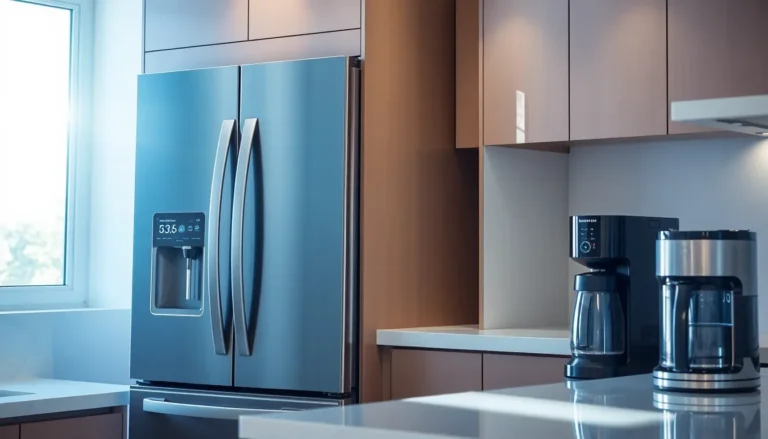Imagine walking into a store where your shopping cart knows your favorite snacks better than your best friend. Welcome to the world of IoT in retail, where everyday shopping transforms into a high-tech adventure. From smart shelves that alert staff when they’re running low on your beloved chips to personalized promotions popping up on your smartphone, the Internet of Things is revolutionizing how retailers connect with customers.
Table of Contents
ToggleOverview of IoT in Retail
IoT technology transforms retail environments, optimizing operations and enhancing customer experiences. Smart shelves automatically track inventory levels, alerting staff when popular items run low. Retailers use connected devices to gather customer data, allowing for tailored promotions directly to shoppers’ smartphones.
Connected devices create a seamless shopping journey, integrating online and offline experiences. Smart mirrors in fitting rooms recommend apparel based on user preferences. IoT applications enable real-time analytics, helping retailers understand shopping patterns and preferences better.
Data driven decisions emerge from the insights gained through IoT integration. Sensors monitor customer behaviors, allowing retailers to adjust layouts and product placements. Trackable interactions help brands personalize marketing strategies, effectively boosting customer engagement.
Automation also plays a critical role in inventory management. Retailers deploy IoT sensors to manage supply chains efficiently, ensuring timely restocking of vital products. This technology results in reduced waste and decreased operational costs.
In-store experiences continuously improve through IoT-enabled devices. Beacons send location-based notifications to customers, enriching their interactions with brands. This strategic use of IoT fosters loyalty and encourages repeat visits.
Ultimately, the application of IoT in retail fosters innovation and adaption, meeting the evolving demands of consumers. By embracing this technology, retailers strengthen their competitive advantage and enhance the overall shopping experience.
Benefits of IoT in Retail
IoT technology provides significant advantages in the retail sector. These benefits enhance operations, improve customer interactions, and streamline processes.
Enhanced Customer Experience
Customer experience improves with IoT integration. Smart mirrors in fitting rooms offer personalized outfit suggestions, increasing engagement. Interactive displays can highlight promotions tailored to individual preferences, capturing attention more effectively. Location-based notifications from beacons encourage timely offers, enhancing customer satisfaction. Personalized shopping journeys lead to higher investment and loyalty levels among consumers. Retailers gain valuable insights into customer behavior through data analytics, allowing them to refine service offerings continuously.
Improved Inventory Management
IoT revolutionizes inventory management practices. Sensors monitor stock levels in real-time, triggering alerts for low inventory. This responsiveness ensures retailers can avoid stockouts and overstock situations, optimizing operating costs. Automated systems streamline the restocking process, significantly reducing human error and labor costs. Utilizing data analytics, retailers identify sales trends, helping to forecast future demands accurately. Effective inventory management directly correlates to increased efficiency and minimized waste, ultimately contributing to enhanced profitability.
Challenges of Implementing IoT in Retail
Implementing IoT in retail faces several challenges that can affect efficiency and security.
Security Concerns
Security concerns are significant when integrating IoT systems. Retailers confront the risk of data breaches that can compromise customer information and business operations. In a recent survey, 63% of businesses reported increasing cybersecurity threats linked to IoT devices. Protecting sensitive data through robust encryption methods becomes crucial to mitigating these risks. Additionally, securing network connections used by IoT devices is essential to prevent unauthorized access. Regular software updates and vulnerability assessments enable retailers to maintain a strong security posture against evolving threats.
Integration Issues
Integration issues hinder smooth IoT deployment in retail settings. Various IoT devices often operate on different platforms, complicating data sharing and interoperability. Retailers might struggle to connect legacy systems with new IoT solutions, leading to inefficiencies. A study indicates that 48% of organizations cite difficulty in integrating existing infrastructure as a primary barrier to IoT adoption. Effective data management and seamless software solutions are necessary to unify these technologies. Establishing clear protocols and standards aids in overcoming integration challenges, ensuring cohesive operation and data synchronization across all systems.
Case Studies of IoT Applications in Retail
IoT applications are transforming retail environments, offering valuable insights and enhancing customer interactions. Numerous successful implementations illustrate how retailers can leverage this technology.
Successful Implementations
Walmart uses IoT to track inventory levels in real-time. By deploying smart shelves, the retailer reduces stockouts and minimizes excess inventory. Target employs IoT-enabled beacons to send customized promotions, significantly increasing customer engagement. Sephora integrates smart mirrors in their stores, providing personalized product recommendations based on customer preferences. These applications not only enhance shopping experiences but also drive sales and operational efficiency.
Lessons Learned
Retailers faced challenges during IoT integration, particularly regarding data security and system compatibility. Many companies underestimated the importance of robust cybersecurity measures. Nearly 63% of businesses reported heightened cybersecurity threats associated with IoT devices. Additionally, over 48% of organizations highlighted difficulties in connecting legacy systems with IoT solutions. Addressing these issues requires effective data management strategies and clear protocols. Success hinges on understanding the significance of these challenges and developing proactive solutions.
Future Trends in IoT for Retail
Integration of artificial intelligence (AI) is set to redefine how retailers utilize IoT. AI algorithms analyze data collected from smart devices, improving customer targeting and personalization. Companies leveraging this synergy can expect enhanced interactive experiences, such as automated checkout systems that streamline the purchasing process.
Adoption of 5G technology accelerates the data transfer rates among IoT devices. Retailers benefiting from faster connectivity experience real-time inventory management and enriched customer interactions. Qualcomm’s report indicates that 5G can increase the effectiveness of IoT applications by up to 100 times compared to current networks.
Utilization of augmented reality (AR) is projected to rise in retail settings. Retailers employing AR can create immersive shopping experiences, allowing customers to visualize products in their environments before making a purchase. For instance, beauty brands are incorporating AR for virtual try-ons, significantly enhancing customer engagement.
Sustainability is becoming a critical focus area in IoT applications. Retailers increasingly invest in IoT-enabled solutions that monitor energy usage and optimize supply chains for minimal waste. Intelligent systems can predict consumer preferences, enabling just-in-time production strategies that align with sustainability goals.
Robust cybersecurity measures will also emerge as a priority for connected retail systems. As reported by Cybersecurity Ventures, global spending on IoT security is anticipated to exceed $3 billion by 2025. Retailers integrating secure protocols can protect sensitive data while maintaining customer trust.
Monitoring customer sentiment through IoT devices will gain traction. Sensors and feedback loops will enable retailers to gauge shopper satisfaction in real-time. This approach allows for immediate adjustments, enhancing the overall shopping experience.
The forthcoming trends in IoT for retail reflect an industry poised for transformation. Continued advancements will build more integrated, efficient, and customer-centric retail environments.
Conclusion
The integration of IoT in retail is reshaping the industry by enhancing customer experiences and optimizing operations. As retailers adopt these technologies they gain valuable insights that drive data-driven decisions. This not only improves inventory management but also fosters customer loyalty through personalized interactions.
While challenges like security and system integration remain, proactive strategies can mitigate these risks. The future of retail lies in embracing IoT advancements, including AI and AR, to create more engaging shopping environments. As these trends unfold, retailers who adapt will likely thrive in an increasingly competitive landscape, ensuring they meet evolving customer expectations.







